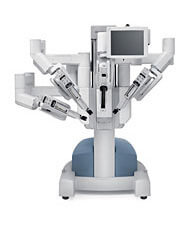Our Services
 General Surgery
General Surgery
Cleared for general laparoscopic procedures, the da Vinci® Surgical System is designed to enable general surgeons to perform many abdominal laparoscopic procedures such as:
- Treatment of chronic reflux disease or Gastroesophageal reflux (GERD)
- Gastric bypass for obesity (also known as Bariatric Surgery)
- Heller myotomy to treat achalasia (a rare disease of the muscle of the esophagus)
- Abdominal aortic artery surgery
- Adrenalectomy
Gynecology
 The robotic technique has allowed surgeons to offer a minimally invasive
approach to their gynecology patient. Utilizing robotic technology, surgeons
can treat some of gynecology's most complex problems including:
The robotic technique has allowed surgeons to offer a minimally invasive
approach to their gynecology patient. Utilizing robotic technology, surgeons
can treat some of gynecology's most complex problems including:
- Removal of fibroid tumors (myomectomy)
- Removal of the uterus (hysterectomy)
- Correction of vaginal prolapse
- Treatment of gynecologic cancers
- Urogynecology
These procedures are usually performed through large abdominal incisions resulting in significant postoperative pain, blood loss and scarring.
Renal Surgery
Robotic-Assisted Living Donor Nephrectomy
A decade ago laparoscopic technology revolutionized the field of surgery, creating a new generation of minimally invasive procedures. Today, surgeons at RWJBarnabas Health have taken that technology one step further. They are using robotics to perform both living donor nephrectomies (kidney removal) and implantation of the kidney into the recipient.
In fact, Stuart R. Geffner, M.D., Director of Kidney and Pancreas Transplant Surgery, RWJBarnabas Health Renal and Pancreas Transplant Division, is the first in the world to use the Intuitive Surgical's da Vinci ™ Surgical System to successfully implant a kidney into a living recipient. This procedure revolutionizes kidney transplant surgery, taking an open procedure to an advanced form of laparoscopic surgery.
"Robot-assisted technology is a remarkable surgical tool. It's an advanced form of laparoscopic surgery that allows us to do precision work with less trauma to the patient," states Dr. Geffner.
How It Works
Utilizing the da Vinci Surgical System, the surgeon sits in a console a few feet from the patient and views the surgical site through a high-definition 3D viewer. A laparoscopic camera and robotic probes (arms) are inserted into the patient through four half-inch incisions. The surgeon uses hand controls and foot pedals to manipulate the robotic arms. These pencil-sized probes translate the surgeon's hand movements and adjust themselves to compensate for the natural tremor of the human hand. Dr. Geffner notes that the equipment can be set to make the tiniest movements with rock-steady precision.
The end of the robotic arm articulates 360 degrees, affording complete range of movement. "It gives us much greater dexterity and range of motion, more so than the human wrist," explains Dr. Geffner. "Therefore, when we remove or implant a kidney we greatly reduce the amount of tissue damage." The donor kidney is removed fully intact through a small three-inch bikini line incision. With robotics, the implantation requires a 5 cm incision which is just large enough to introduce the kidney into the recipient’s body. It is approximately one-third the size of a conventional “open” transplant incision.
Benefit to Donors and Recipients
For the patient, robot-assisted surgery is safe, minimally invasive and offers faster recovery time. Patients usually leave the hospital within a day or two and resume normal activity shortly thereafter.
Dr. Geffner hopes that this new technology and the ease with which kidneys can be removed will encourage more people to become living donors. Nearly 75,000 people in the United States are waiting for a kidney transplant. Many have to wait three to five years before they find a match. A shortage of living donors is one reason for the long wait. As Dr. Geffner concludes, "Robotics is a technology that will clearly evolve. It's only going to get better, for our patients as well."
Adult Urology
Robotic surgery has allowed surgeons the ability to perform procedures for the prostate, kidneys and bladder with minimally invasive incisions. Our surgeons have found that most urologic procedures can be performed in a minimally invasive fashion without the need for the patient to donate blood. The hospital stays and recovery periods have been dramatically reduced.
Urological procedures include:
- Prostate Cancer and Robotic (da Vinci®) Prostatectomy
-
Kidney Cancer and Robotic Nephrectomy and Partial Nephrectomy
TCC and Nephroureterectomy - UPJ Obstruction and Pyeloplasty
- Bladder Cancer and Radical Cystectomy
- Benign Prostatic Hyperplasia (BPH) and Simple Prostatectomy
- Vesicoureteral Reflux and Ureteral Reimplant
Pediatric Urology

The advent of robotic surgery has opened the door to many exciting new possibilities for minimally invasive surgery for children. With the da Vinci® System, the surgeon only needs to make small incisions, which translates into decreased blood loss, reduced postoperative pain and a quicker recovery from surgery. These benefits are so important for active children who are eager to get back to their normal daily routines. Quicker recovery time means less time spent in the hospital following surgery, thereby reducing the stress levels for both the parent and child.
The Pediatric Urology procedures performed using Robotic Surgery include:
- Ureteropelvic Junction Obstruction and Pyeloplasty
- Orchiepexy
- Nephrectomy
![]() To locate a robotic surgeon, visit our
physician finder.
To locate a robotic surgeon, visit our
physician finder.
